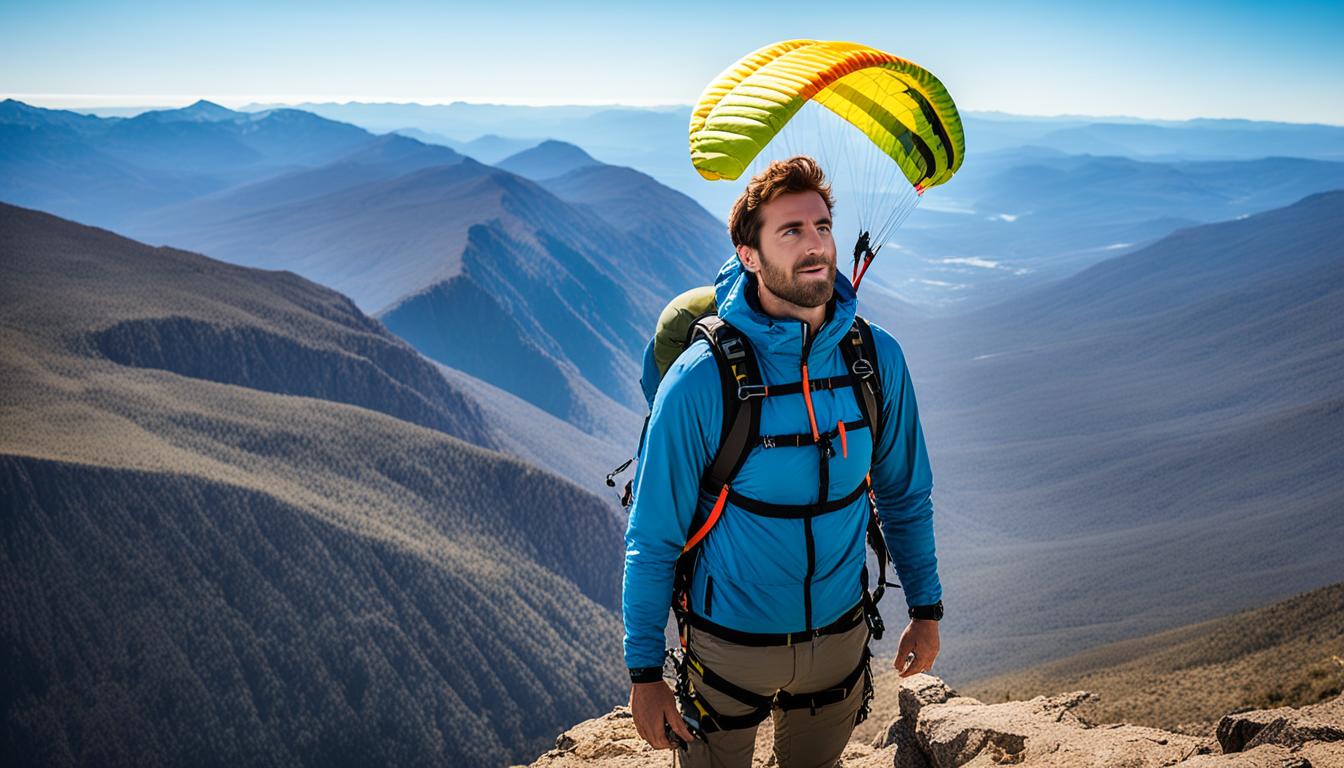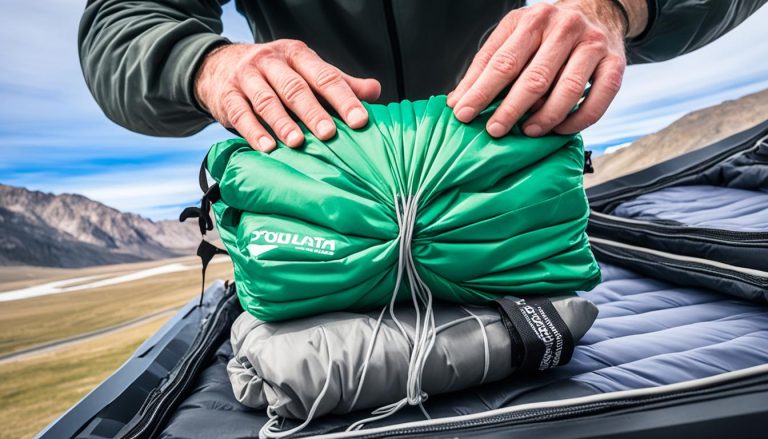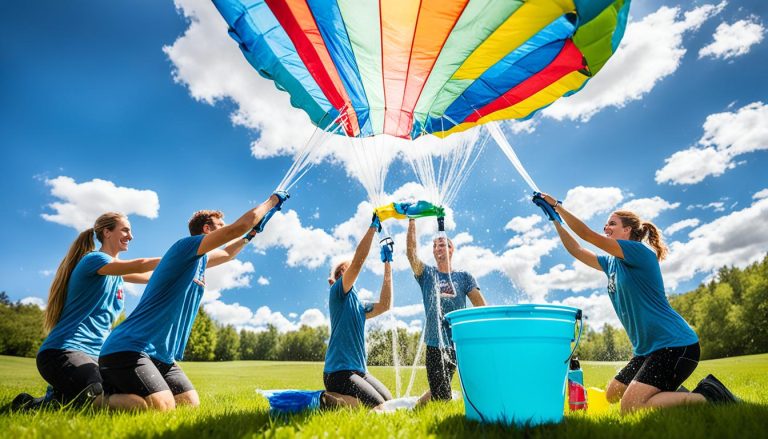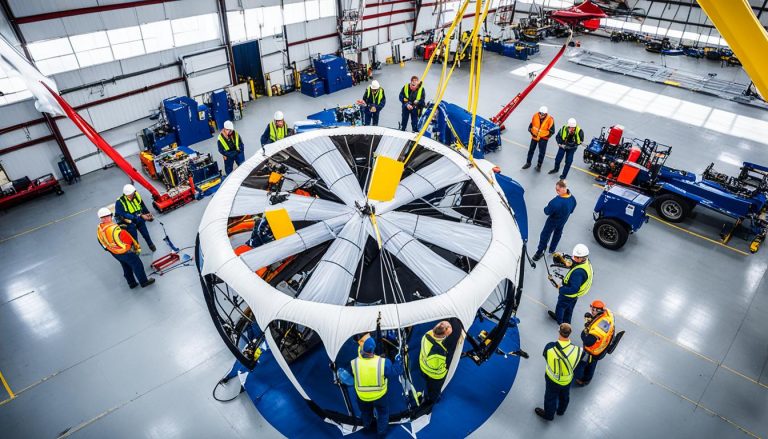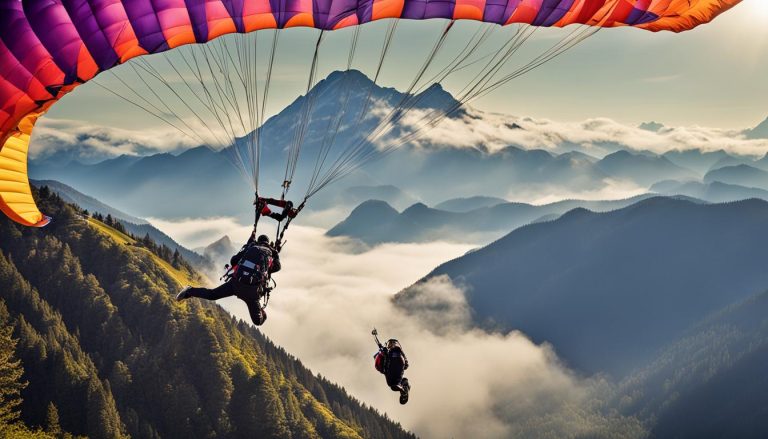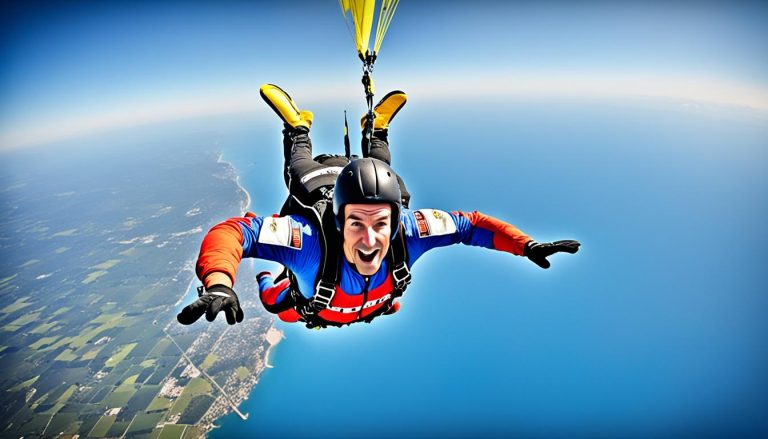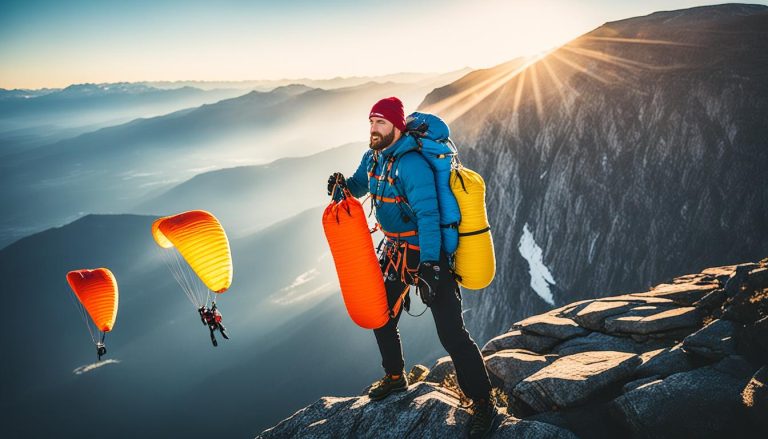A beginner’s guide to choosing your first parachute to jump from the top of the mountains
BASE jumping is a thrilling sport that involves jumping from fixed structures without the use of an aircraft. It requires highly trained athletes, and choosing the right parachute is crucial for safety. BASE stands for Building, Antenna, Span (referring to bridges), and Earth (meaning cliffs or rock formations). BASE jumping is a dangerous sport that should only be attempted by those who have received proper training. It is estimated that BASE jumping accidents are 43 times more likely to occur than skydiving accidents. Before attempting BASE jumping, it is important to train with a certified skydiving instructor and gain experience through many successful jumps.
In this guide, we will explore the key factors to consider when choosing your first parachute for jumping from the top of the mountains. Whether you’re a novice seeking beginner-friendly options or an experienced skydiver venturing into the world of BASE jumping, we have you covered. From parachute selection to the essential mountain jumping gear, let’s ensure you’re well-equipped for this exhilarating adventure.
Choosing the right parachute is the single most important decision you’ll make as a BASE jumper. It determines your safety, control, and overall experience during the jump. There are various factors to consider, such as canopy size, deployment speed, and wing loading. It is crucial to understand your skill level, environment, and personal preferences when selecting the perfect parachute for your mountain jumps.
Throughout this guide, we will provide valuable insights and recommendations to help you make an informed decision. From understanding the different types of parachutes to exploring the best options for beginners, we aim to equip you with the knowledge and confidence necessary to embark on your BASE jumping journey from the top of the mountains.
Understanding BASE Jumping and Parachute Gear
BASE jumpers are fearless thrill-seekers who leap from fixed structures and cliffs, defying gravity with the help of a parachute and sometimes a wingsuit. This extreme sport requires specialized equipment that ensures safety and performance during descent. Let’s explore the world of BASE jumping gear and the best options for beginners.
Gear Essentials for Beginners
When it comes to mountain skydiving safety, having the right equipment is crucial. Here are some essential pieces of gear for beginners:
- Parachute: The parachute is the lifeline for every BASE jumper. It needs to deploy quickly and fill with air efficiently. A reliable parachute is essential for a safe landing.
- Wingsuit: While a wingsuit is not mandatory for BASE jumping, many adrenaline enthusiasts choose to wear one. Wingsuits allow jumpers to slow their descent and maneuver through the air with precision. However, it’s important to note that a parachute is still necessary for a controlled landing.
BASE jumping gear has evolved over time to meet the specific needs of jumpers. Manufacturers have focused on creating compact and lightweight equipment, making it easier for jumpers to transport their gear to different locations.
The Best Parachutes for Beginners
“Choosing the best parachute is a critical decision for any beginner in BASE jumping. Safety should always be the top priority, and selecting the right parachute can ensure a smooth and controlled landing.”
Here are some top-rated parachutes recommended for beginners:
| Parachute Model | Features |
|---|---|
| Brand A | Quick deployment, high stability, and excellent glide ratio. |
| Brand B | Lightweight design, fast inflation, and responsive controls. |
| Brand C | Durable construction, reliable performance, and easy packing. |
Choosing the best parachute for beginners involves considering factors such as deployment speed, stability, controllability, and overall performance. It’s recommended to consult experienced BASE jumpers or instructors for personalized advice based on your skydiving goals and skill level.
Remember, the best parachute for beginners may vary depending on personal preferences and specific jumping environments. Prioritize safety, thorough training, and gradually progress as you gain experience in the world of BASE jumping.

The Best Places for BASE Jumping from Mountains
While BASE jumping can potentially be done from any tall stationary object, there are certain locations around the world that are famous for their embrace of the sport. These destinations offer not only thrilling jumps but also breathtaking scenery that adds to the overall experience. Whether you are a seasoned BASE jumper or a first-time adrenaline seeker, these mountain locations are worth considering for your next adventure.
Troll Wall, Norway
Famous for its vertical cliffs, the Troll Wall in Norway is an iconic spot for mountain BASE jumping. With a height of about 3,600 feet, this majestic wall provides ample opportunities for adrenaline-fueled leaps. The stunning Norwegian landscape surrounding the Troll Wall adds to the thrill and beauty of the experience.
Perrine Bridge, Idaho
Located in Idaho, the Perrine Bridge is a popular destination for BASE jumpers. Standing at a height of 486 feet, this bridge offers challenging jumps and breathtaking views of the Snake River Canyon. Its accessibility and proximity to the city of Twin Falls make it convenient for both experienced jumpers and newcomers to the sport.
Angel Falls, Venezuela
A perfect combination of natural beauty and exhilarating jumps, Angel Falls in Venezuela is the world’s highest waterfall. With a height of 3,212 feet, this majestic waterfall provides an awe-inspiring backdrop for BASE jumping. The incredible height and surrounding lush greenery make it a bucket-list destination for adventure seekers.
Burj Khalifa, Dubai
Known as the tallest building in the world, the Burj Khalifa in Dubai offers a unique and thrilling experience for BASE jumpers. Standing at a jaw-dropping height of 2,717 feet, this iconic skyscraper presents an exciting challenge for adrenaline junkies. The panoramic views of the cityscape from the top make it an unforgettable leap.
New River Gorge Bridge, West Virginia
Nestled in the picturesque Appalachian Mountains of West Virginia, the New River Gorge Bridge is not only a marvel of engineering but also a popular BASE jumping spot. Standing at a height of 876 feet, this impressive steel arch bridge offers breathtaking views of the surrounding forests and river. The annual ‘Bridge Day’ event attracts BASE jumpers from around the world to take part in this exhilarating experience.
Navagio Beach, Greece
Navagio Beach, also known as Shipwreck Beach, is a stunning location on the Greek island of Zakynthos. Surrounded by towering cliffs and crystal-clear turquoise waters, this beach attracts not only sunbathers but also adventurous BASE jumpers. The dramatic cliffs provide an exhilarating platform for jumps, with the breathtaking beach as the landing zone.
Meru Peak, India
Located in the Garhwal Himalayas of Uttarakhand, India, Meru Peak offers a thrilling experience for mountain BASE jumping enthusiasts. Standing at an impressive altitude of 21,850 feet, this challenging and technical ascent rewards jumpers with awe-inspiring views of the surrounding snow-capped peaks. It is undoubtedly a destination for experienced jumpers seeking a unique and unforgettable adventure.
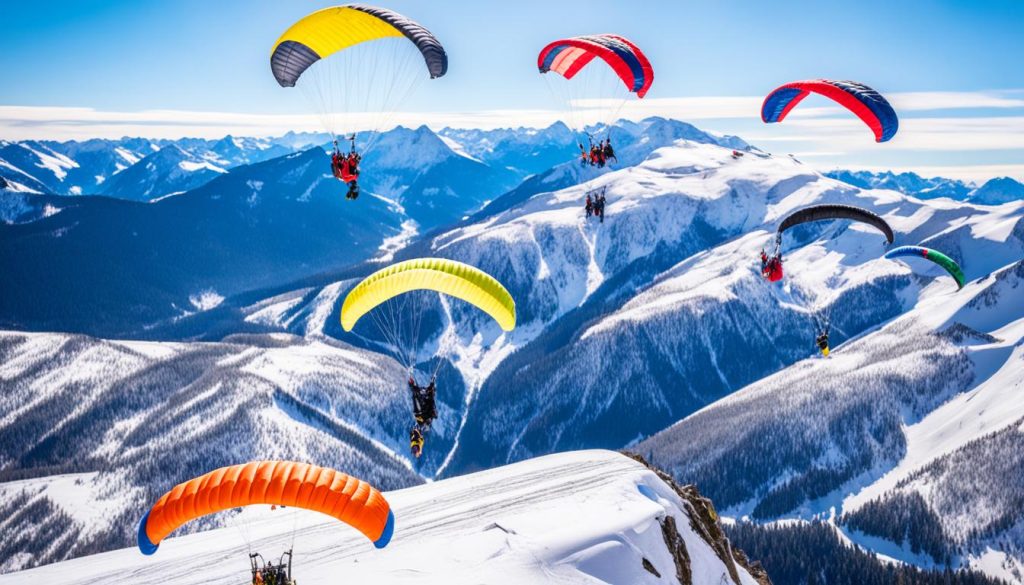
These are just a few of the world’s best places for mountain BASE jumping. Each location offers its own set of challenges and rewards, making it essential for jumpers to be equipped with the right gear and knowledge. Whether you’re a first-time skydiver or an experienced jumper, ensure you have the best parachute for your needs and consider the various paragliding equipment options available to ensure a safe and thrilling experience.
Progression in Skydiving and Wingsuit Flying
To become a wingsuit skydiver, it is recommended to start by becoming an experienced and competent skydiver. Skydiving provides the foundation of skills and knowledge needed for wingsuit flying. After earning a certification in solo skydiving, the next step is to work towards a B-license, which involves continuing to practice freefall and landing accuracy requirements. Once you have accumulated 50-200 jumps, you can begin focusing on skills that will prepare you for wingsuit flying, such as freeflying and improving tracking abilities.
Next Steps in Wingsuit Progression
Once you’ve surpassed 50-200 jumps and gained some experience in BASE jumping, it’s time to start working towards a C-license. This phase of your journey is dedicated to further developing your freefall skills, canopy landing accuracy, and tracking abilities.
To expand your skill set and enhance your body awareness and control, it is recommended to explore different disciplines within the sport. Try your hand at freeflying, where you can experiment with different body positions and perform acrobatic maneuvers in the air. Additionally, engaging in canopy relative work can help you refine your canopy control and learn how to fly in close proximity to other jumpers.
During this phase, it’s crucial to research and familiarize yourself with wingsuit equipment from various manufacturers. Understanding the different categories of wingsuits and the options available will enable you to make an informed decision when it comes time to purchase or rent your own wingsuit. Ensure the wingsuit you choose suits your skill level and personal preferences.
Categories of Wingsuits
There are several categories of wingsuits tailored to different skill levels and flying styles. Here are some common categories:
- Beginner/Intermediate Wingsuits: Designed for jumpers who are new to wingsuit flying or have limited experience. These wingsuits offer stability and ease of use, making them perfect for acclimatizing to the wingsuit environment.
- Advanced Performance Wingsuits: Geared towards experienced wingsuit flyers who want to push their skills further. These wingsuits have a more aggressive design, offering increased speed, lift, and agility.
- Competition Wingsuits: Built for competitive wingsuit flying and racing. These wingsuits prioritize speed, performance, and precision.
- Specialty Wingsuits: Tailored to specific disciplines within wingsuit flying, such as proximity flying or flocking. These wingsuits feature unique modifications to enhance specific aspects of the flying experience.
When selecting a wingsuit, consider factors such as your experience level, desired flying style, wingsuit design, wing loading, and safety features. Consult with experienced wingsuit flyers, instructors, and gear experts for guidance in choosing the right wingsuit for you.
Wingsuit Equipment Checklist
As you progress in wingsuit flying, it’s crucial to have the right gear to ensure your safety and comfort. Here’s a checklist of essential wingsuit equipment:
| Item | Description |
|---|---|
| Wingsuit | A properly sized and well-fitted wingsuit that matches your flying style and skill level. |
| Helmet | A certified helmet that provides protection and comfort. |
| Goggles | Clear or tinted goggles to protect your eyes while maintaining visibility. |
| Altimeter | A reliable altimeter to monitor your altitude during the jump. |
| Reserve Parachute | A fully functional and well-maintained reserve parachute as a backup in case of emergency. |
| Jump Suit | A jumpsuit specifically designed for wingsuit flying to minimize drag and enhance flying performance. |
| Knife | A small, easily accessible knife for cutting away tangled lines or other entanglements. |
| ALT/TEK | An audible altimeter that provides audible alerts based on pre-set altitude parameters. |
Remember, your safety should always be a top priority. Regularly inspect and maintain your gear, seek guidance from experienced wingsuit flyers, and continue to enhance your skills through proper training and knowledge acquisition.
Conclusion
Choosing your first parachute to jump from the top of the mountains is an exciting and challenging endeavor. But above all, safety should always be your top priority. It is crucial to undergo proper training and gain experience in BASE jumping and wingsuit flying before attempting any mountain skydiving adventure. By following the progression outlined in this guide and working with certified instructors and mentors, you can safely explore the thrilling world of mountain skydiving.
Remember that your training is an ongoing process. Continuously improve your skills, practice diligently, and seek to expand your knowledge in the sport. Stay up to date with the latest gear and safety practices, as the world of skydiving is constantly evolving. With the right equipment and the right mindset, you can confidently embark on the exhilarating journey of mountain skydiving.
When it comes to beginners skydiving equipment and mountain skydiving gear, it is essential to choose gear that meets your specific needs and skill level. Consult with experienced skydivers or instructors to select a parachute that is suitable for jumping from the top of mountains. Remember, each jump is unique, and having the right equipment tailored to your requirements can significantly enhance your safety and enjoyment.

